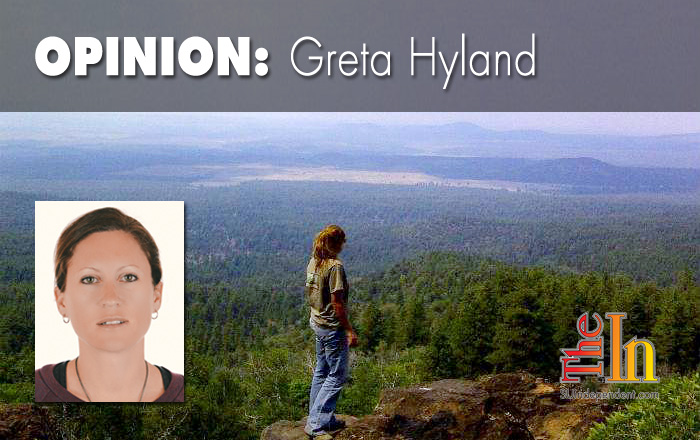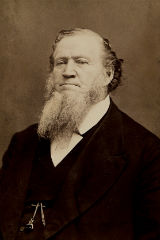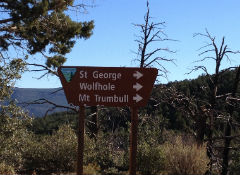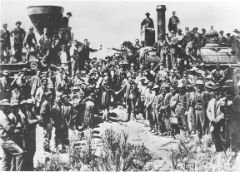OPINION: Ken Ivory and Gov. Herbert are bamboozling you about public lands

Written by Greta Hyland
 In order to understand the articulate and legal language used by Ken Ivory in his defense of transferring public lands to the state, you have to understand what he is arguing. Ken Ivory believes that the Enabling Act was a compact, whereby both parties were to get and give something, that it was a two way street. This is true, but not the way he is arguing it. He is proposing a legal theory: that the U.S. had a duty to dispose of federal lands. To put another way, he states that the U.S. promised to give the land to the states upon entry into the Union. In today’s world, this sounds legitimate, but when you dig into the history, you see that Ivory is ascribing intentions to historical parties that were never there. In other words, he is rewriting history.
In order to understand the articulate and legal language used by Ken Ivory in his defense of transferring public lands to the state, you have to understand what he is arguing. Ken Ivory believes that the Enabling Act was a compact, whereby both parties were to get and give something, that it was a two way street. This is true, but not the way he is arguing it. He is proposing a legal theory: that the U.S. had a duty to dispose of federal lands. To put another way, he states that the U.S. promised to give the land to the states upon entry into the Union. In today’s world, this sounds legitimate, but when you dig into the history, you see that Ivory is ascribing intentions to historical parties that were never there. In other words, he is rewriting history.
Why would he do this? Because there is great wealth in those lands and he has come up with a novel way to argue for control of them. According to a recent article in The New American, “Utah State Rep. Ken Ivory, one of the summit organizers, noted that there is an estimated $150 trillion in mineral resources “locked up in federal lands” across the West.” That’s a big reason to wrest control of those lands. Of course no one knew this in the late 1800s, but if Ivory can make it appear that way, maybe the courts will relent. Surely the people of the Utah territory must have realized those lands would be worth something at some time and would have demanded they eventually be turned over, right? Probably not.
While this might fool Utah constituents, I doubt it will fool the courts.
First, let’s look at the idea of the Enabling Act being a compact between the state of Utah and the U.S. government. There is some truth to that. In order to be admitted into the Union Utah had to comply with conditions required for statehood to demonstrate their loyalty and to show they would become “Americanized.” Because the Utah territory was run by the Mormon Church, their loyalty was in question. The issue of polygamy and Mormon political power could also be seen as an issue of trust and loyalty; as one anti-Mormon advocate wrote in 1869: “It is time to understand whether the authority of the nation or the authority of Brigham Young is the supreme power in Utah.” Critics of the Mormon Church saw it as a potentially disloyal body that could not be trusted with control over a state government (The Price of Admission).
 |
| Brigham Young |
As a territory, they were under the plenary power of Congress which meant Congress could use legislation to suppress polygamy and even the Mormon Church itself, and it did. So in essence, they had no sovereign rights or protections. Statehood would grant Utah constitutional rights, federal protections, and state sovereignty. They applied for statehood in the 1860s and wanted it badly enough that they were willing to accept almost any conditions to have it. There were three main conditions they had to meet: 1. They had to forever revoke polygamy; 2. They were required to provide a public school system free from sectarian (church) control; and 3. The Mormon Church had to give up political power in the state by disbanding its political arm, the People’s Party, and ensure that a fair and republican form of government was established. It took some doing, but roughly 20 years after petitioning the government for statehood the conditions were met and Utah was accepted into the Union with the passing of the Enabling Act in 1896 (The Price of Admission).
Utah acquiesced to all the demands and did become a state. As for the federal government’s obligation under the Enabling Act, that obligation was constitutional. The obligation of the U.S. government is covered under the Guarantee Clause in the Constitution: The United States shall guarantee to every State in this Union a Republican Form of Government, and shall protect each of them against invasion and domestic violence. There is nothing suggesting a “promise” to transfer land to the states or that the states had any sovereign rights or powers over federal lands.
There is, however, great power given to the U.S. over federally owned lands under the Property Clause of the constitution which states: The Congress shall have power to dispose of and make all needful rules and regulations respecting the territory or other property belonging to the United States; and nothing in this Constitution shall be so construed as to prejudice any claims of the United States, or of any particular State. Ken Ivory states that under the equal footing doctrine, the states should have been given all public lands at entry into the Union, but the courts have not seen it that way. They have made the distinction, not by a definition of a compact, but by constitutional powers.
 |
| Arizona Strip BLM land |
When it comes to questions of state sovereignty verses federal sovereignty, the court has relied on lines that delineate certain areas as “truly national” and certain areas as “truly local.” There have been cases where enabling act conditions were overturned because the court saw the conditions as Congress overstepping their bounds. However, “the court has been careful to emphasize that federal powers in regard to federal land came from the constitution, not from the admission compacts or conditions. Even if unequal distribution of federal lands within the states meant that newer states would face an increased burden from the same federal land conditions compared to other states that had little or no federal land, there was no infringement of state equality, even if new states had agreed to substantially different conditions related to those lands (The Price of Admission).”
As a result, conditions related to federal and Indian lands and the grants of lands by the federal government to the new states have been uniformly upheld by the courts as within Congress’s power. In Nevada v. United States, where Nevada, much like Utah, passed legislation demanding public land and sued over it, the court found that, “federal regulation which is otherwise valid is not a violation of the ‘equal footing’ doctrine merely because its impact may differ between various states because of geographic or economic reasons and therefore the large amount of federal land in Nevada can be placed under stringent management restrictions without violating the equal footing doctrine.”
While Nevada did not sue under a duty to dispose, they did argue under their enabling act which is virtually the same as Utah’s in regard to public land. But all that aside, the federal government has disposed of lands quite extensively and has been since this country was founded. Nearly 816 million acres of the public domain lands were transferred to private ownership between 1781 and 2006. Furthermore, according to a CRS Report to Congress, at least one section (1/36th) of every 6-mile square township was given to the states for the maintenance of public schools within the said township (State Trust Land). In total, the federal government has disposed of 1.275 billion acres of the 1.841 billion acres it acquired from state cessions, foreign treaties, and land purchases.
 |
| Golden Spike Promontory Point, UT |
I would argue that the states would not make better managers of the land. Furthermore, I would suggest that the federal government is under no duty to dispose of public lands, even though they have done so; but rather that it is their prerogative. The truth is, the government has, with respect to its own lands, the rights of an ordinary proprietor or private individual and may sell or withhold from sale, as was found in Canfield v. United States.
The bottom line is Ken Ivory and his ilk want the land so they can sell it to industry and extract all the wealth from it. How they will afford to pay for wildland firefighters, environmental degradation and contamination, loss of wildlife and subsequent hunting and angling dollars, or afford to lose any of the $6 billion in recreation and tourism dollars is beyond me. And this says nothing of the inherent danger in privatizing public lands.
While they state they would keep parks and wilderness areas under federal control, how many other pristine and little known spots will suddenly be off limits? And how long before those federally protected places are encroached upon or ruined by private interests? Even though I don’t think Utah will win this fight, all outdoorsmen and women should be alarmed at the thought of a state takeover of public lands. Those lands are our lands and were given to us in trust; ensuring this land ethic and heritage was one of the best and most visionary decisions ever made by our government. What will happen to the great outdoors if new managers take over? I seriously doubt the states will manage better, be as equitable, or continue to promote the priceless values found in those lands. Anything worth having is worth fighting for. We cannot afford to let the states dominate this conversation and bamboozle us into thinking it is good for us.
 |
| Teddy Roosevelt |
“Of all the questions which can come before this nation, short of the actual preservation of its existence in a great war, there is none which compares in importance with the great central task of leaving this land even a better land or our descendants than it is for us, and training them into a better race to inhabit the land and pass it on. Conservation is a great moral issue, for it involves the patriotic duty of insuring the safety and continuance of the nation.”
~Teddy Roosevelt
Notes:
***Ken Ivory, in arguing for federal transfer of public lands, points to Illinois and Florida as examples of states winning public lands from the federal government, but that is like comparing apples and oranges. Both Illinois and Florida were admitted into the Union before the Civil War which was a game changer for admittance into the Union, and which drastically changed how Congress admitted new states. Furthermore, neither states’ enabling acts had language like that found in Utah’s and other western states’ enabling acts. Florida, admitted in 1845, was required to “never interfere with the primary disposal of the public lands lying within [its borders], nor levy any tax on the same whilst remaining the property of the United States.” Illinois, admitted in 1818, was required to be consistent with the Northwest Ordinance, and Illinois was required to not tax lands sold by the United States for five years, and to not tax non-resident property owners at a higher rate than resident property owners (1).***
***The American Lands Council is a non-profit organization started by Ken Ivory to take back public lands. Both he and his wife collect paychecks from it while lobbying western lawmakers to support H.B. 148, Transfer Public Lands Act, which Ivory sponsored. Conflict of interest? Unethical? http://www.sltrib.com/sltrib/politics/57952776-90/ivory-lands-utah-state.html.csp***
Greta Hyland has a Masters degree in Environmental Policy & Management and has worked for the BLM and the NPS as well as for non-profit organizations. She is a regular contributor to the Utah Adventure Journal and is the Copy Editor at the Independent. She writes regularly on her blog about environmental policy issues affecting the southwest, as well as personal narratives about outdoor recreation and simple living. Her blog can be found at www.thesouthwestjournal.wordpress.com A Utah native, Greta is a consummate desert rat and loves exploring the southwest. She can be reached at [email protected].
Related Stories: Transfer of public lands will cost us in more ways than one
The misconception about public land: It’s not ours
 EXCLUSIVE: Why Senator Urquhart thinks equal housing and job legislation will pass
EXCLUSIVE: Why Senator Urquhart thinks equal housing and job legislation will pass
POLL: Do you think charges should have been brought against the New York City Police?
OPINION: Justice and Independent 2015 – where were they in the death of Eric Garner?
Healthy Recipe of the Week: Breakfast Tofu Scramble
WELLNESS: Living a life with purpose: holiday cheer
OPINION: Ken Ivory and Gov. Herbert are bamboozling you about public lands
Christmas Album Review: The Irish Rovers ‘Merry Merry Time of Year’
CARTOON ‘Caught on Camera’ by Clay Jones
SUNDAY HIKE: Middle Fork Taylor Creek – Kolob Canyons
LOCAL WORSHIP GUIDE: Spiritual and religious gatherings in southern Utah
OUR BEST OF THE WEEK
December Print Edition PDF
Click on the right to get our Sunday Edition via email –>




